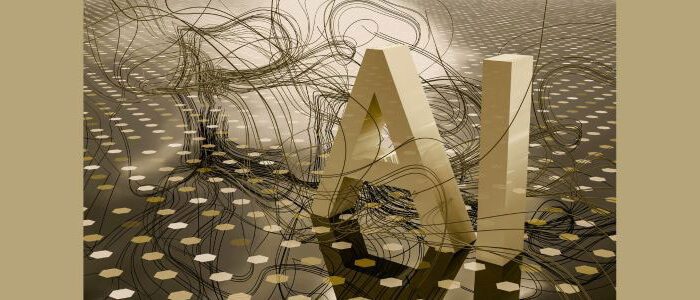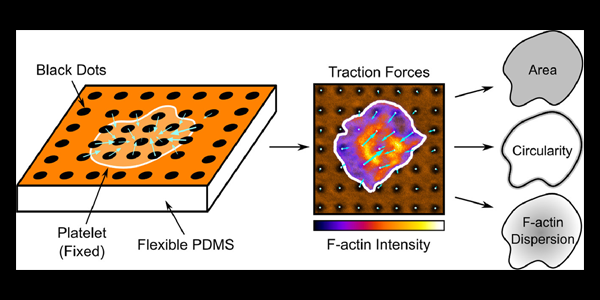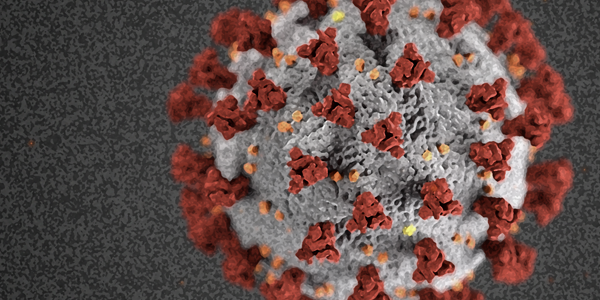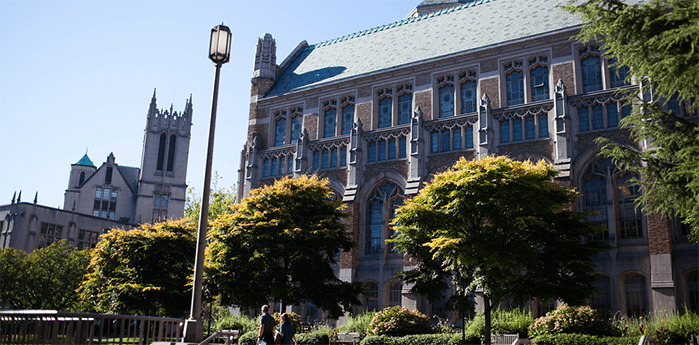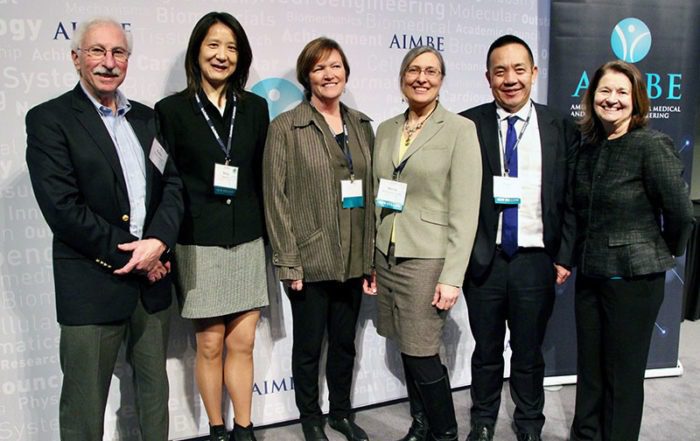Professor
Vice Chair of Academic Affairs
wendyt@uw.edu
Phone: (206) 616-3947
Office: Foege N430P
Wendy Thomas
Mechanobiology
Molecular biophysics
Thrombosis
Infection
Computational
Adhesion
Protein Engineering
To study the biophysics of catch bonds, we apply and develop engineering tools such as single molecule biophysics instrumentation. We also study the role of catch bonds in cell adhesion by using integrative simulations to relate nanoscale to microscale behaviors, and by using site-directed mutagenesis to change molecular properties so we can see how the cell behavior changes. To develop new adhesive technology, we use the biophysics tools we have developed to predict and characterize desired properties for different applications. We also use protein engineering tools including RosettaDesign and directed evolution to engineer proteins with the desired properties.
MS, Applied Mathematics, University of Washington 2003
AB, Molecular Biology, Princeton University 1987
2017: Fellow, American Institute of Medical and Biological Engineering (AIMBE)
2016: University of Washington Undergraduate Research Mentor Award
2016: University of Washington Distinguished Teaching Award
2016: University of Washington College of Engineering Faculty Teaching Award
2007-2010: BMES Board of Directors
2007: American Heart Association National Scientist Development Grant
2007: National Science Foundation CAREER Award
1999-2003: Whitaker Foundation Graduate Fellowship
BIOEN 485/585: Computational Bioengineering
Interlandi, G. and W.E. Thomas. “Mechanism of allosteric propagation across a B-sheet structure investigated by molecular dynamics simulations,” Proteins 84 p. 990-1008 (April 2016)
Tronic, E.H., O. Yakovenko, T. Weidner, J.E. Baio, R. Penkala, D.G. Castner, and W.E. Thomas, “Differential surface activation of the A1 domain of von Willebrand factor,” Biointerphases, 11 029803 (March 2016)
Yakovenko, O., V. Tchesnokova, E.V. Sokurenko, W.E. Thomas, “Inactive conformation enhances binding function in physiological conditions,” PNAS 112, p. 9884-9889 (Aug 2015)
Kisiela D.I., H. Avagyan, A. Jalan, S. Gupta, G. Interlandi, Y. Liu, V. Tchesnokova, V.B. Rodriguez, X. Wu, W.E. Thomas, and E.V. Sokurenko, “Inhibition and reversal of microbial attachment by antibody with parasteric activity against FimH adhesin, the vaccine target against uropathogenic E. coli”, PLoS Pathogens 11 p. e1004857 (May 2015).
Whitfield, M.J., J.P. Luo, W.E. Thomas, “Yielding Elastic Tethers Stabilize Robust Cell Adhesion,” PLoS Computational Biology 10, p. e1002371 (Dec 2014)
Kisiela, D.I., V.B. Rodriguez, V. Tchesnokova, H. Avagyan, P. Aprikian, Y. Liu, X.R. Wu, W.E. Thomas, E.V. Sokurenko, “Conformational inactivation induces immunogenicity of the receptor-binding pocket of a bacterial adhesin” PNAS 110, p. 19089-94 (Nov 2013)
Rodriguez, V.B, B.A. Kidd, G. Interlandi, V. Tchesnokova, E.V. Sokurenko, W.E. Thomas, “Allosteric Coupling in the Bacterial Adhesive Protein FimH”, J. Biol Chem 288 (33), 24128-39 (July 2013)
Liu, Y., Esser, L., Interlandi, G., Kisiela, D. I., Tchesnokova, V., Thomas, W. E., Sokurenko, E., Xia, D., Savarino, S. J., “Tight Conformational Coupling between the Domains of the Enterotoxigenic Escherichia coli Fimbrial Adhesin CfaE Regulates Binding State Transition,” J Biol Chem, 288, p. 9993-10001 (Feb 2013)
Interlandi, G, M. Ling, A.Y. Tu, D. W. Chung, and W. E. Thomas, “Structural basis of type 2A von Willebrand disease investigated by molecular dynamics simulations and experiments”PLoS One, 7, p. e45207 (Oct 2012)
Tchesnokova V., P. Aprikian, D. Kisiela, S. Gowey, N. Korotkova, W. Thomas, E. Sokurenko, “Type 1 fimbrial adhesin FimH elicits immune response which enhances cell adhesion of Escherichia coli” Infection and Immunity, 79, p. 3895-3904 (Oct 2011)
Aprikian, P, G. Interlandi, B. Kidd, I. Le Trong, V. Tchesnokova, O. Yakovenko, M. Whitfield, E. Bullitt, R. Stenkamp, W.E. Thomas, E.V. Sokurenko, “The Bacterial Fimbrial Tip Acts as a Mechanical Force Sensor” PLoS Biology, (May 2011) 9, p. e1000617
Whitfield, M, W.E. Thomas*, “A nanoadhesive composed of receptor-ligand bonds”, Journal of Adhesion, in press
W.E. Thomas*, D.E. Discher*, Prasad Shastri*, “Mechanical regulation of cells by materials and tissues”, MRS Bulletin, 35 p. 578-583 (2010).
Whitfield MJ, Ghose T, Thomas WE, “The shear-stabilized rolling behavior of E. coli examined with simulations.” Biophysical Journal, 99, p. 2470-78 (2010)
Le Trong I, Aprikian P, Kidd BA, Thomas WE, Sokurenko EV, Stenkamp RE, “Donor strand exchange and conformational changes during E. coli fimbrial formation.” Journal of Structural Biology, 172, p. 380-88 (2010)
Interlandi G, Thomas WE, “The catch bond mechanism between von Willebrand Factor and platelet surface receptors investigated by molecular dynamics simulations” Proteins 78 p. 2506-22 (Aug 2010)
Bao, G, Kamm RD, Thomas W, Hwang W, Fletcher DA, Grodzinsky AJ, Zhu C, Mofrad MRK “Molecular Biomechanics: The Molecular Basis of How Forces Regulate Cellular Function.” Cellular and Molecular Bioengineering 3 p 91-105 (June 2010)
Le Trong I, Aprikian P, Kidd BA, Forero-Shelton M, Tchesnokova V, Rajagopal P, Rodriguez V, Interlandi G, Klevit R, Vogel V, Stenkamp RE, Sokurenko EV, Thomas WE, “Structural basis for mechanical force regulation of the adhesin FimH via finger trap-like beta sheet twisting” Cell 141 p 645-55 (May 2010) (NIHMS version free text)
Tchesnokova V, McVeigh AL, Kidd B, Yakovenko O, Thomas WE, Sokurenko EV, Savarino SJ, “Shear-enhanced binding of intestinal colonization factor antigen I of enterotoxigenic Escherichia coli” Molecular Microbiology 76 p 489-502 (April 2010)
Kidd BA, Baker D*, and Thomas WE* “Computation of Conformational Coupling in Allosteric Proteins” PLoS computational Biology 5 p e1000484 (Aug 2009)
Thomas, WE*. Mechanochemistry of receptor-ligand bonds. Current Opinion in Structural Biology (2009)
Sokurenko EV*, Vogel V, Thomas WE. Catch-Bond Mechanism of Force-Enhanced Adhesion: Counterintuitive, Elusive, but … Widespread? Cell Host and Microbe 4 p 314-323 (2008)
Nilsson, L. M., Thomas, W. E., Sokurenko, E. V., Vogel*, V. Beyond induced-fit receptor-ligand interactions: structural changes that can significantly extend bond lifetimes. Structure 16 p. 1047-58 (2008)
Ronald LS, Yakovenko O, Yazvenko N, Chattopadhyay S, Aprikian P, Thomas WE, Sokurenko EV*. Adaptive mutations in the signal peptide of the type 1 fimbrial adhesin of uropathogenic Escherichia coli PNAS 105 p. 10937-42 (2008)
Thomas WE. Catch Bonds in Adhesion. Ann Rev. Biomed Eng 10: p 39-57 (2008)
Thomas WE. Vogel, V. and Sokurenko, E. Biophysics of Catch Bonds. Annual Review of Biophysics 37: p 399-416 (2008)
Yakovenko O, Sharma S, Forero M, Tchesnokova V, Aprikian P, Kidd B, Mach A, Vogel V, Thomas WE. FimH forms catch bonds that are enhanced by mechanical force due to allosteric regulation. J Biol Chem 283(17) p 11596-605 (2008)
Tchesnokova V, Aprikian P, Yakovenko O, LaRock, C, Kidd B, Vogel V, Thomas W, and Sokurenko E. Integrin-like allosteric properties of the catch-bond forming FimH adhesin of E. coli. J Biol Chem 283(12) p 7823-33 (2008)
Korotkova N, Yang Y, Le Trong I, Cota E, Demeler B, Marchant J, Thomasn WE, Stenkamp RE, Moseley SL and Matthews S, Binding of Dr adhesins of Escherichia coli to carcinoembryonic antigen triggers receptor dissociation. Molecular Microbiology 67(2) p 420-434 (2008)
Aprikian P, Tchesnokova V, Kidd B, Yakovenko O, Yarov-Yarovoy V, et al. 2007. Interdomain Interaction in the FimH Adhesin of Escherichia coli Regulates the Affinity to Mannose. J Biol Chem 282: 23437-46
Anderson, B., A. Ding, L. Nilsson, K. Kusuma, V. Tchesnokova, V. Vogel, E. Sokurenko, and W.E. Thomas, ” Weak Rolling Adhesion Enhances Bacterial Surface Colonization “. J. Bac. 189(5): 1794-802.(2007)
Thomas, W.E. , “Understanding the Counterintuitive Phenomenon of Catch Bonds”. Current Nanotechnology. (in press)
Thomas, W.E. , “For catch bonds, it all hinges on the interdomain region”. J Cell Biol. 2006 174(7): 911-3.
Forero, M., O. Yakovenko, E.V. Sokurenko, W.E. Thomas, and V. Vogel, “Uncoiling Mechanics of Escherichia coli Type I Fimbriae Are Optimized for Catch Bonds”. PLoS Biol 2006. 4(9): 1509-1516.
Nilsson, L.M., W.E. Thomas, E.V. Sokurenko, and V. Vogel, Elevated Shear Stress Protects Escherichia coli Cells Adhering to Surfaces via Catch Bonds from Detachment by Soluble Inhibitors. Appl Environ Microbiol, 2006. 72(4): p. 3005-10.
Nilsson, L., W.E. Thomas, E. Trintchina, V. Vogel, and E.V. Sokurenko “Catch bond-mediated adhesion without a shear threshold: trimannose versus monomannose interactions with the FimH adhesin of Escherichia coli.” . J Biol Chem 2006. 84(24) 16656-63.
Thomas, W.E ., M. Forero, O. Yakovenko, L. Nilsson, P. Vicini, E.V. Sokurenko, and V. Vogel, Catch Bond Model Derived from Allostery Explains Force-Activated Bacterial Adhesion. Biophys J, 2006. 90(3): p. 753-64.
Pereverzev, Y.V., O.V. Prezhdo, W.E. Thomas, and E.V. Sokurenko, Distinctive features of the biological catch bond in the jump-ramp force regime predicted by the two-pathway model. Phys Rev E Stat Nonlin Soft Matter Phys, 2005. 72(1 Pt 1): p. 010903.
Pereverzev, Y., O.V. Prezhdo, M. Forero, E. Sokurenko, and W.E. Thomas, The Two-Pathway Model for the Catch-Slip Transition in Biological Adhesion. Biophys J, 2005. 89(3): p. 1446-1454.
Thomas, W.E ., L. Nilsson, M. Forero, E.V. Sokurenko, and V. Vogel, “’Stick-and-roll’ bacterial adhesion mediated by catch-bonds” Molecular Microbiology, 2004. 53: p. 1545
M. Forero , W. E. Thomas, C. Bland, L. Nilsson, E.V. Sokurenko, and V. Vogel, “A Catch-Bond Based Smart Nano-Adhesive Sensitive to Shear Stress” Nano Letters 2004 , 4(9); p. 1593-1597
Thomas, W.E ., E. Trintchina, M. Forero, V. Vogel, and E.V. Sokurenko, “Bacterial adhesion to target cells enhanced by shear force” Cell, 2002. 109(7): p. 913-23
Krammer, A., D. Craig, W.E. Thomas, K. Schulten, and V. Vogel, “A structural model for force regulated integrin binding to fibronectin’s RGD-synergy site” Matrix Biol, 2002. 21(2): p. 139-147
Vogel, V., W.E. Thomas, D.W. Craig, A. Krammer, and G. Baneyx, “Structural insights into the mechanical regulation of molecular recognition sites” Trends Biotechnol, 2001. 19(10): p. 416-23
Thomas, W.E . and J.A. Glomset, “Affinity purification and catalytic properties of a soluble, Ca2+-independent, diacylglycerol kinase” Biochemistry, 1999. 38(11): p. 3320-6
Thomas, W.E . and J.A. Glomset, “Multiple factors influence the binding of a soluble, Ca2+-independent, diacylglycerol kinase to unilamellar phosphoglyceride vesicles” Biochemistry, 1999. 38(11): p. 3310-9
In the News
UW Bioengineering faculty embrace AI tools to enhance teaching and learning
2025-03-21T07:09:14-07:00March 18th, 2025|
UW Bioengineering Celebrates Women’s History Month
2024-03-11T15:29:08-07:00March 5th, 2024|
Black Dots: High-Yield Traction Force Microscopy Reveals Structural Factors Contributing to Platelet Forces
2022-01-06T14:43:44-08:00January 6th, 2022|
UW Bioengineers pivot to develop coronavirus solutions
2022-08-01T14:43:01-07:00July 9th, 2020|
2017 Faculty Promotions: Albert Folch, Xiaohu Gao, Wendy Thomas, Deok-Ho Kim, Anthony Convertine
2020-10-26T08:28:54-07:00October 5th, 2017|
Valerie Daggett, Wendy Thomas, Rong Tian and Chun Yuan inducted as 2017 AIMBE Fellows
2020-10-26T08:29:23-07:00April 5th, 2017|





